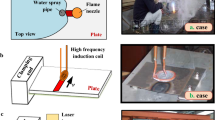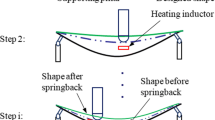Abstract
Thermal stress forming is an important method of bending with the advantages of no mold, high flexibility, and wide range of processed materials. It is the hot spot and the future trend of advanced processing method. However, thermal stress bending technology cannot achieve the effect of mechanical forming (large bending angle), which restricts the development of this technology. In order to solve this problem, an auxiliary thermal stress bending method (baffle moment method, BMM) is proposed. A coupled thermodynamic model of the method is developed through simulation, and the bending angle variation law and forming mechanism are investigated. The results show that the BMM can increase the bending angle by 78.75 times compared with the traditional method. The reason is that BMM can form a larger pressure and bending moment in the heating zone. The bending angle increases with the increase of laser power, displacement. The bending angle decreases with increasing scanning speed, laser diameter, plate thickness, and center distance. The difference between negative and positive bending moments on the increase of bending angle is small (0.09 deg), and the direction of bending moment plays a decisive role in the bending direction. This method requires only a simple baffle device and no complex tooling, which helps to reduce the cost and improve the forming efficiency.



















Similar content being viewed by others
Data availability
The results of the experimental tests are available upon request.
References
Bachmann AL, Dickey MD, Lazarus N (2020) Making light work of metal bending: laser forming in rapid prototyping. Quantum Beam Science 4(4):210–218
Shi YJ, Yao ZQ, Shen H (2005) Angular deformation analysis of laser thermal stress sheet metal forming. J Nanjing Univ Aeronaut Astronaut 37:35–41
Ji ZS, Liu YJ (2001) Research and prospect of hull curved plate processing technology. J Dalian Univ Tech 41(005):505–510
Das B, Biswas P (2018) A review of plate forming by line heating. J Sh Prod Des
Ji ZS, Sun ZL (1998) Theory and application of line heating forming process for hull curved plate. China shipp A10:118–124
Fan P, Chen MH, Huang YC (2008) Experimental study on high frequency induction thermal stress forming of sheet metal. Forg Stamping Technol 33(4):3842
Li JH, Su ZC, Yao FP (2017) Application of BP neural network in laser bending forming of aluminum alloy plate. Hot Work Technol 46:58–165
Fu SC, Yang LJ, Zhang HZ (2018) Analyses of effects of process parameters on laser bending of stiffened panels. Int J Precis Eng Man 19:593–604
Dutta PP, Kalita K, Dixit US (2018) Electromagnetic-force-assisted bending and straightening of AH36 steel strip by laser irradiation. Laser Man Mater Process 5(3):1–21
Kant R, Bhuyan PM, Joshi SN (2015) Experimental studies on TGM and BM dominated curvilinear laser bending of aluminum alloy sheets. Lasers Based Manufacturing. Springer India
Ravi K, Shrikrishna N, Joshi U (2015) Laser forming systems: a review. Int J Mechatron Manuf Syst 8(3/4):160–205
Rattan A, Jasra Y, Saxena RK (2020) Prediction of bending behavior for laser forming of lime coated plain carbon steel using finite element method. Mater Today Proc 28
Magee J, Sidhu J, Cooke RL (2000) A prototype laser forming system. Opt Laser Eng 34(4–6):339–353
Yang LJ, Chen YL, Wei YJ (2016) Experimental study on laser induced hot forming of 5A06 aluminum alloy plate. J Eng Sci Technol 33
Safari M, Ebrahimi M (2016) Numerical investigation of laser bending of perforated sheets. J Adv Des Manuf Technol 9:53–60
Guan YJ, Sun S (2002) Experimental study on the effect of scanning times on laser bending of sheet metal. Photoelectron Laser 11:1163–1166
Zhang Y, Dong W, Qiao Y, Zhang C (2019) Edge effect investigation of DP980 steel sheet in multiple laser scanning process. Int J Precis Eng Manuf 20:319–326
Wang Y, Lu H, Tan JG (2003) Study on laser heating bending of sheet metal. Laser Tech 03:16–18
Cai YG, Wang XF, Chen GG (2009) Laser bending test of sheet metal. J Beijing Univ Aeronaut Astronaut 02:154–157
Shi YJ (2007) Study on laser thermal deformation mechanism and thermal forming process planning of complex curved panel. J Shanghai Jiaotong Univ
Mjali KV, Els-Botes A, Mashinini PM (2017) The effects of laser and mechanical forming on the hardness and microstructural layout of commercially pure grade 2 titanium alloy plates
Ding L (2010) Research on laser bending technology of aluminum lithium alloy sheet. Jiangsu University
Kant R, Joshi SN (2019) A numerical investigation into the effect of forced convection cooling on the performance of multi-scan laser bending process. Application of lasers in manufacturing
Lambiase F, Di Ilio A, Paoletti A (2016) Productivity in multi-pass laser forming of thin AISI 304 stainless steel sheets. Int J Adv Manuf Technol 86(1–4):259–268
Kalvettukaran P, Das S, Marimuthu S (2018) Increment in laser bending angle by forced bottom cooling. Int J Adv Manuf Technol 94(5–8):2137–2147
Otsu M, Ito Y, Ishii A (2007) Effect of heat treatment and transformation on bending angle in laser forming of titanium foils. Key Eng Mater 344:243–250
Abedi HR, Gollo MH (2019) An experimental study of the effects of surface roughness and coating of Cr2O3 layer on the laser-forming process. Opt Laser Technol 109:336–347
Rattan A, Jasra Y, Saxena RK (2020) Prediction of bending behavior for laser forming of lime coated plaincarbon steel using finite element method. Mater Today Proc 28:1943–1950
Gautam SS, Singh SK, Dixit US (2015) Laser forming of mild steel sheets using different surface coatings. In Lasers Based Manufacturing (AIMTDR 2014): 17–39
Fetene BN, Dixit US, Liao H (2017) Laser bending of friction stir processed and cement-coated sheets. Mater Manuf Process :1–7
Liu H, Wang C, Liu Z (2021) Numerical prediction of machining-induced surface residual stress for TC4 cryogenic turning. Int J Adv Manuf Technol 114(5–8)
Xu HJ, Yin LX, Li JW (2005) Microstructure and properties of electron beam welded joint of TC4 titanium alloy. Acta Weld Sinica 26(011):43–46
Liu P, Liu Y, Cai B (2019) A dynamic Bayesian network based methodology for fault diagnosis of subsea Christmas tree. Appl Ocean Res 94
Ni C, Zhu L, Liu C (2018) Analytical modeling of tool-workpiece contact rate and experimental study in ultrasonic vibration-assisted milling of Ti-6Al-4V. Int J Mech Sci 142–143:97–111
Liu HW (1985) Advanced material mechanics, Higher education press
Zhang SS (2009) Mechanics of materials, China Machine Press
Funding
The work presented in this paper was supported by the National Natural Science Foundation of China (No. 51175515), PetroChina Innovation Foundation (No. 2017D-5007–0307), and the Fundamental Research Funds for the Central Universities (No. 18CX05004A).
Author information
Authors and Affiliations
Contributions
Yankuo Guo performed data acquisition and processing and wrote the article manuscript. Feng Guo conceived and developed the theory and supervised the findings of this work at all stages. Yongjun Shi and Shuyi Li discussed the results and contributed to the review of the final manuscript.
Corresponding author
Ethics declarations
Ethics approval
This work did not involve human subjects and/or animals. Thus, no ethical approval was required.
Consent to participate
This work did not involve collection of information from human subjects.
Consent for publication
This work did not involve collection of information from human subjects. All authors of this work have expressed consent for their names and affiliations to appear in this journal publication.
Conflict of interest
The authors declare no competing interests.
Additional information
Publisher's Note
Springer Nature remains neutral with regard to jurisdictional claims in published maps and institutional affiliations.
Rights and permissions
About this article
Cite this article
Guo, Y., Shi, Y., Guo, F. et al. An auxiliary thermal stress forming method for realizing large angle. Int J Adv Manuf Technol 121, 4847–4864 (2022). https://doi.org/10.1007/s00170-022-09659-2
Received:
Accepted:
Published:
Issue Date:
DOI: https://doi.org/10.1007/s00170-022-09659-2




